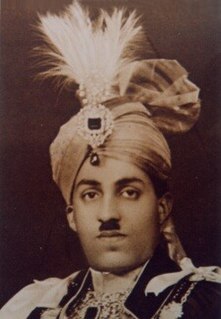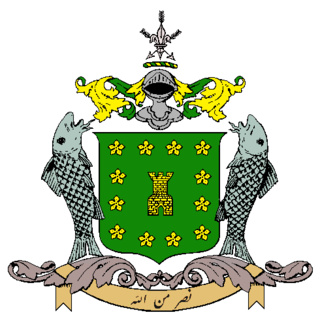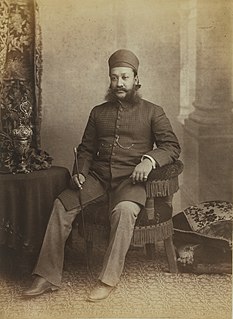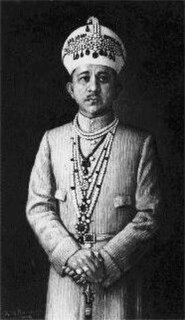Related Research Articles

The Nizams were the 18th-through-20th-century rulers of Hyderabad. Nizam of Hyderabad was the title of the monarch of the Hyderabad State. Nizam, shortened from Nizam-ul-Mulk, meaning Administrator of the Realm, was the title inherited by Asaf Jah I. He was the viceroy of the Great Mughal in the Deccan, the premier courtier in Mughal India in 1724, and the founding "Nizam of Hyderabad".

General Nawab Sir Sadiq Muhammad Khan V Abbasi was the Nawab, and later Amir, of Bahawalpur State from 1907 to 1966. He became the Nawab on the death of his father when he was only three years old. A Council of Regency, with Sir Rahim Bakhsh as its President, ruled on his behalf until 1924.

The Nawabs of Bhopal were the Muslim rulers of Bhopal, now part of Madhya Pradesh, India. The nawabs first ruled under the Mughal Empire from 1707 to 1737, under the Maratha Empire from 1737 to 1818, then under British rule from 1818 to 1947, and independently thereafter until it was acceded to the Union of India in 1949. The female nawabs of Bhopal held the title Nawab Begum of Bhopal.

The Nizam College is a constituent college of Osmania University established in 1887 during the reign of Mir Mahbub Ali Khan, Asaf Jah VI, in Basheerbagh, Hyderabad, Telangana.

Paigah is a family in the senior aristocracy of Hyderabad State, who were associated with ruling Nizam since its inception. and each maintained his own court, individual palaces, and a standing army of about fourteen thousand troops, both infantry and cavalry.

Shamshabad is a administrative headquarters of Ranga Reddy district in the Indian state of Telangana. It is located in Shamshabad mandal of Rajendranagar revenue division. The international airport of Hyderabad is located here.

Vikarabad is a town and mandal in Vikarabad district of the Indian state of Telangana. It is located in Vikarabad mandal of Vikarabad revenue division. Vikarabad is famous for higher education institutes such as Sri Anantha Padmanabha College and Osmania University College Vikarabad for Self Finance.
Fāʾiz is a male Arabic name meaning "successful" and "victorious" overflowing, plenty.

Sir Viqar ul-Umara, Iqtidar ul-Mulk, Iqbal ud-Dowla, Secundar Jung, Nawab Muhammad Fazl-ud-din Khan Bahadur, was the Prime Minister of Hyderabad from 1893 to 1901, and also served as the Amir e Paigah from 1881 to 1902.

Nawab Sir Muhammad Mazharuddin Khan Bahadur, commonly known as Sir Asman Jah or Nawab Sir Asman Jah Bahadur, was an Indian noble who served as Prime Minister of Hyderabad from 1887 to 1894. A member of the powerful Paigah family, Asman Jah built the Asman Garh Palace, Basheer Bagh Palace, and Mahboob Chowk Clock Tower. He represented Nizam Mahbub Ali Khan at the Golden Jubilee of Queen Victoria.

Paigah Palace was built by Sir Vicar-ul-Umra, a Paigah nobleman. This was built after he gave the famous Falaknuma Palace to the sixth Nizam of Hyderabad state, Mahbub Ali Khan, Asaf Jah VI. The Palace houses the Consulate General of the US in Hyderabad.

Paigah Tombs or Maqhbara Shams al-Umara, are the tombs belonging to the nobility of Paigah family, who were fierce loyalists of the Nizams, served as statespeople, philanthropists and generals under and alongside them. The Paigah tombs are among the major wonders of Hyderabad State which known for their architectural excellence as shown in their laid mosaic tiles and craftsmanship work. The Paigah's necropolis is located in a quiet neighbourhood 4 km southeast of Charminar Hyderabad, at Pisal banda suburb, down a small lane across from Owasi Hospital near Santosh Nagar. These tombs are made out of lime and mortar with beautiful inlaid marble carvings. These tombs are 200 years old which represent the final resting places of several generations of the Paigah Nobles.

Nawab Abul Quasim Owaisi, Mir Yousuf Ali Khan, Salar Jung III (1889–1949), commonly known as Salar Jung III, was a nobleman and art collector from Hyderabad Deccan. He served as Prime Minister of Hyderabad Deccan during the reign of the seventh Nizam, Mir Osman Ali Khan. In 1912, at the age of twenty-three, Salar Jung III succeeded Maharaja Sir Kishen Pershad as Prime Minister and served for two and a half years. He held the fourth-highest position among the Hyderabad Deccan nobility, below three members of the Paigah family.

Nawab Muhammad Yusef Ali Khan Bahadur, KSI, was a Nawab of the princely state of Rampur from 1855 to 1865. During the First War of Independence, he rendered many useful services to the Government of India by keeping the British supply and communication lines to Naini Tal open, rescuing fugitives and securing the town of Moradabad. For his service, he was granted extensive lands in Bareilly by the Viceroy of India, Lord Canning, was knighted in 1861 and given a 13-gun salute along with the style of His Highness. Finally, he was made a member of the Viceroy's Council. Despite this multitude of honours, Sir Yusef continued to preserve the Mughal artistic tradition by inviting musicians, scholars and artists of Bahadur Shah Zafar II's court to resettle at Rampur, including the great poet Ghalib. Dying at 49 in 1865, he was succeeded by his son, Sir Kalb Ali Khan Bahadur.

Hajji Nawab Kalb Ali Khan Bahadur was a Nawab of the princely state of Rampur from 1865 to 1887. Succeeding his father, Sir Nawab Yusef Ali Khan Bahadur, he continued his father's good works, expanding the Rampur library, constructing the Jama Masjid costing Rs.3 lakhs and encouraging the spread of education, irrigation, architecture, literature and art in general. A gifted ruler, Sir Kalb Ali Khan was highly literate in Arabic and Persian and patronised scholars from across India and the Islamic world. He was a member of John Lawrence's governance council from 1878 to his death, attended the Delhi Durbar of Queen Victoria and was granted a personal salute of 17-guns. He was succeeded at his death in 1887, aged 55, by his son, Muhammad Mushtaq Ali Khan Bahadur.

Nawab Sayyid Hamid Ali Khan Bahadur was Nawab of the princely state of Rampur from 1889 to 1930.

Sir Raza Ali Khan Bahadur GCIE, KCSI was a nawab of the princely state of Rampur from 1930 to 1966. A tolerant and progressive ruler, Sir Raza expanded the number of Hindus in his government Including his Prime Minister Lt.Col. Horilal Varma Bar At Law and, expanded the irrigation system, completed electrification projects and continued building schools, roads and sewage systems. Also the Nawab sent his soldiers to fight in the Middle Eastern theatres of the Second World War. Acceding to the Union of India on 15 August 1947, Rampur was formally merged with it in 1949 and with the new state of Uttar Pradesh in 1950. Afterwards, Sir Raza devoted himself to charitable projects and to his post as head of the Freemasons in India as the first Grand Master of the Grand Lodge of India.

Pisal Banda is a locality in Santoshnagar neighbourhood of Hyderabad, Telangana, India. It is well known for being the site of the historic Paigah Tombs and Phisal Banda Palace of Nawab Zafar Jung Bahadur of Khursheed Jahi Paigah, a rich Nobleman and an amateur astronomer in Hyderabad in 1901 when he bought a 6 inch telescope from England. He installed it in his Pisal Banda Palace premises in a Seven storey Almirah type building, Hyderabad. He requested that it be called Nizamiah Observatory after the sixth Nizam of Hyderabad, Mir Mahboob Ali Khan. Nawab Zafar Jung Bahadur died in 1907 and as per his request the Nizam's Government take over the Observatory. In accordance with his wishes, the administration of the Observatory was taken over by the Finance Department of the Nizam's Government in 1908.[2][3]

The Spanish Mosque, also known as Masjid Iqbal Ud Daula or Jam e Masjid Aiwan-E-Begumpet, is a mosque within the Paigah Palace, Begumpet, Hyderabad, India.
Lutfuddaulah Oriental Research Institute is an Indian research institute in the state of Hyderabad. It was named after Nawab Lutf ud-Dowlah Muhammad Lutf ud-Din Khan Bahadur Latafat Jang and was founded by Hakeem Sayyid Shamsullah Qadri circa 1937.
References
- ↑ "Archive News". The Hindu . 20 October 2010. Archived from the original on 24 October 2010. Retrieved 1 December 2016.